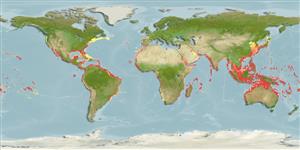>
Carangiformes (Jacks) >
Carangidae (Jacks and pompanos) > Caranginae
Etymology: Selar: A Malay vernacular name, ikan selar.
More on author: Bloch.
Environment: milieu / Klimaatzone / Diepte / distribution range
Ecologie
marien rifbewoner; diepte 0 - 170 m (Ref. 9283), usually 2 - 10 m (Ref. 40849). Subtropical; 47°N - 31°S, 180°W - 180°E
Circumtropical. Indo-Pacific: East Africa (Ref. 3287) to Rapa, north to southern Japan and the Hawaiian Islands, south to New Caledonia. Eastern Pacific: Mexico to Peru, including the Galapagos Islands (Ref. 5530). Western Atlantic: Nova Scotia, Canada and Bermuda through the Gulf of Mexico and the Caribbean to to São Paulo (Ref. 47377), Brazil. Eastern Atlantic: Cape Verde to southern Angola (Ref. 7097).
Lengte bij maturiteit / Grootte / Gewicht / Leeftijd
Maturiteit: Lm 17.7 range ? - ? cm
Max length : 70.0 cm TL mannelijk / geslacht onbekend; (Ref. 48635); max. gerapporteerde leeftijd: 3.00 Jaren (Ref. 104735)
Dorsale stekels (totaal) : 9; Dorsale zachte stralen (totaal) : 24 - 27; Anale stekels: 3; Anale zachte stralen: 21 - 23.
Body shape (shape guide): fusiform / normal; Cross section: compressed.
Adults prefer clear oceanic waters around islands to neritic waters (Ref. 5217). Occasionally in turbid waters (Ref. 9283). Pelagic (Ref. 58302). Individuals travel in compact groups of hundreds of thousands of fish. Mainly nocturnal in habit, they disperse at night to feed on small shrimps, benthic invertebrates, and forams when inshore, and zooplankton and fish larvae when offshore (Ref. 9283, 90102). Marketed fresh and salted or dried (Ref. 9283). Reported to reach 70 cm TL (Ref. 48635).
Smith-Vaniz, W.F., 1995. Carangidae. Jureles, pámpanos, cojinúas, zapateros, cocineros, casabes, macarelas, chicharros, jorobados, medregales, pez pilota. p. 940-986. In W. Fischer, F. Krupp, W. Schneider, C. Sommer, K.E. Carpenter and V. Niem (eds.) Guia FAO para Identification de Especies para lo Fines de la Pesca. Pacifico Centro-Oriental. 3 Vols. FAO, Rome. (Ref. 9283)
Status op de Rode Lijst van het IUCN (Ref. 130435: Version 2025-1)
Gevaar voor de mens
Reports of ciguatera poisoning (Ref. 30911)
Gebruik door de mens
Visserij: van groot commercieel belang; sportvis: ja; aas: usually
Tools
Speciale rapporten
Download XML
Internetbronnen
Estimates based on models
Preferred temperature (Ref.
123201): 20 - 29.2, mean 27.9 °C (based on 6848 cells).
Fylogenetische diversiteitsindex (Ref.
82804): PD
50 = 0.7500 [Uniqueness, from 0.5 = low to 2.0 = high].
Bayesian length-weight: a=0.01349 (0.01211 - 0.01503), b=2.99 (2.96 - 3.02), in cm total length, based on LWR estimates for this species (Ref.
93245).
Trofisch niveau (Ref.
69278): 3.8 ±0.2 se; based on diet studies.
Generation time: 1.0 ( na - na) years. Estimated as median ln(3)/K based on 1
growth studies.
Weerstandsvermogen (Ref.
120179): Hoog, minimale populatieverdubbelingstijd minder dan 15 maanden (K=0.6-0.9).
Prior r = 1.19, 95% CL = 0.79 - 1.79, Based on 8 data-limited stock assessments.
Fishing Vulnerability (Ref.
59153): Low vulnerability (25 of 100).
🛈
Climate Vulnerability (Ref.
125649): High vulnerability (60 of 100).
🛈
Nutrients (Ref.
124155): Calcium = 44.7 [14.5, 96.7] mg/100g; Iron = 0.976 [0.355, 2.254] mg/100g; Protein = 21.2 [19.1, 23.1] %; Omega3 = 0.331 [0.165, 0.686] g/100g; Selenium = 51.7 [18.8, 141.0] μg/100g; VitaminA = 15.1 [3.9, 70.2] μg/100g; Zinc = 0.678 [0.337, 1.145] mg/100g (wet weight); based on
nutrient studies.
